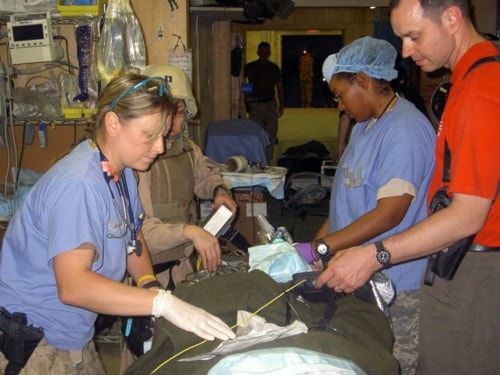A Fernie nurse has seen the trauma of the Afghanistan war, but says that there are many similarities between being a nurse in the Elk Valley and serving as a nurse in Afghanistan.
“I don’t think there is much difference to be honest,” said Jo Ann Hnatiuk, clinical practice educator at the Elk Valley Hospital and reservist with the Canadian military. “You need to be resilient for both places.” She said. “In Fernie and Afghanistan, we don’t have the back up of a big city centre, and you have to be creative and adaptive for both places.”
Hnatiuk grew up in Saskatoon, moving to Calgary in the late ‘90s. She began working casually at the Elk Valley Hospital in 2003.
She said that one obvious difference between Afghanistan and Fernie is the significance of the devastation.
Hnatiuk did her first tour as a reservist nurse in October 2005.
“When I arrived I thought, ‘Man it’s hot,’ and ‘what the hell am I doing here?’” she said.
Hnatiuk was struck by how significant the trauma was.
“There was a lot of fear, but a lot of resilience as well,” she said.
In 2005, when Hnatiuk arrived she was part of the U.S. led mission in Kandahar. The mission was handed over to the Canadian military in February 2006.
“I learned a lot, and I got to do a lot,” she said about her experience. “There was amazing comradery among the military there, and there was also an enormous sense of pride and patriotism.”
Hnatiuk returned to Canada in March 2006, but returned to Kandahar for a second time in May 2007.
“I really realized how significant war is. You really don’t realize the level of violence until you’re there,” she said.
Despite being in the middle of a war zone, Hnatiuk saw humour in many situations.
“We were working and I was just getting ready to end my second tour. We had been hit by an abundance of casualties, and had just settled them all into our intensive care units. Suddenly, we started getting rocketed,” she said.
They had to take all the patients they had just settled in and move them to bunkers and bomb shelters.
“We were putting helmets and bomb blankets on the patients. My friend was escorting an old man in a diaper with a helmet on, to a bomb shelter. All of a sudden we started to laugh, because we just realized how crazy it was,” she said. “You can only really see that when you are in the middle of a situation like that.”
Hnatiuk was also part of the medical evacuation team that helped fly out injured Haitians after the earthquake.
“We took back 600 people; 77 flights were made,” she said. “The people didn’t speak English, and didn’t really speak French either. We were taking them from a disaster zone to Montreal where it was -38 degrees.”
Hnatiuk said that she was struck by how these people had had their whole world destroyed, and had nothing.
“We were flying people back, and had loaded one woman into the helicopter. The door was closing and this vacant stare came across her face, and she asked if it was an aftershock. I told her that it was just the door closing,” she said. “It was such an experience to see the crisis. I can only imagine how scared they must have been, and now they have nothing and it will probably take their country decades to repair.”
Hnatiuk now works educating staff at the Elk Valley Hospital.
“I would go back,” she said. “But there are a lot of people that we have trained and need the experience. I would always go back and help and do my part.”
